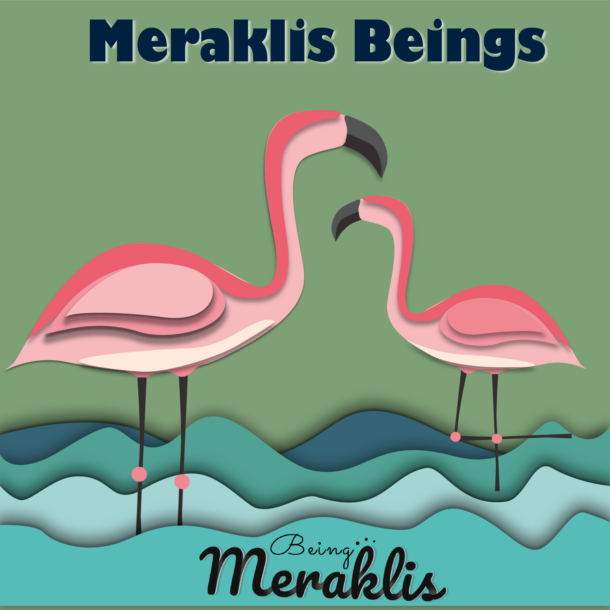
Ep 123 – 5 techniques to calm the mind wherever, whenever

One of the most common complaints I hear from my students learning Pranayama or meditation with me is “Shwetha, we feel great in class, but once we go back to life or to our workspaces, we lose all the calm and are back to feeling stressed, anxious, and emotionally all over the place.”
Is that you too? Then this episode is for you because I’m going to share 5 practices you can adopt anywhere anytime to come back home to that calmness that is within your reach wherever you go.
In today’s episode of the Own Your Everyday series of the Being Meraklis podcast, I share 5 simple practices you can use to calm the mind wherever you are, at home, stuck in traffic, in the office, or at a boring party – doesn’t matter.
But before that, why do we need a calm mind?
Most of us today experience a calm mind, the quietness that needs no words to describe it fleetingly – maybe a moment or two here and there stolen from a vacation years ago. But we all have a memory of that moment – because it comes with a distinctive signature. A peace, unlike anything we’ve ever known or experienced. When our mind is undisturbed, we are fully present – not floating between memories of the past or anxieties of the future. All of us are available in the here and now to ensure we give our best to the task, situation, or challenge at hand.
It was Swami Vivekananda, who said a peaceful mind is a powerful force, and I think you cannot get a more succinct articulation than that. We can accomplish anything with a peaceful mind and in the process ensure
– We don’t act in haste
– We don’t expend more energy than needed to complete the task. Rather we conserve energy for the things that matter most.
– We don’t damage relationships by saying things we don’t mean
– We don’t do irreversible things.
I think we can all see how a calm mind helps us, let’s look at what ruins our peace…
1. Situations – As humans, we make tall plans about what should or shouldn’t happen. But as the saying goes, sometimes life has other plans and our attachment to what should have been causes friction. We get angry, frustrated, or nervous and all of this tosses peace of mind out the window.
2. People – We expect people to be the way we are or how we want them to be. But we are our own unique personalities so how can we really be true to ourselves and alike. So our attachment to people’s roles, actions, and behaviours, causes us suffering.
3. Our thoughts and emotions – Our minds can make a living hell even if we are in paradise. When we constantly shuttle between what has already happened and what is yet to occur we are either depressed or anxious. Like Lao Tzu says, “If you are depressed you are living in the past if you are anxious you are living in the future, if you are at peace, you are living in the present.” So the key then really is how can we come back to the present.
Do you notice how all of them are attachments.. us wanting something to happen a certain way or not happen in a certain way? Jiddu Krishnamurti says beautifully in one of his videos that he doesn’t mind what happens, that’s how he’s at peace and ease at all times. That’s it – he says
“I don’t mind what happens. That is the essence of inner freedom. It is a timeless spiritual truth: release attachment to outcomes, deep inside yourself, you’ll feel good no matter what.”
Just imagine the expansiveness with which we can operate if we can even glimpse this inner freedom for a few brief moments. But all of us are mere mortals… and far far away from this expansiveness. But we needn’t lose heart …. while it may be a long journey, it is by no means impossible to attain. We start small and begin right where we are – amidst the suffering and the chaos and start moving towards it
Are you ready to try some practices to calm the mind that you can do just about anywhere – whether you’re stuck in traffic, commuting to work, in an elevator, waiting for a meeting to begin, or in bed waiting to fall asleep. Wherever you might be, whenever you feel the need, here are 5 practices to calm the mind
1. Observe the breath – The breath is the most accurate indicator of our state of mind at any given point in time. Whenever you remember, start observing the breath. You’re not controlling it or modifying it – simply observe. You can keep your attention focused on the nostrils and see if you can catch an incoming or outgoing breath. Mentally note the state of the breath and see if you can observe patterns. When is it rapid? When is it shallow? When is it relaxed or deep?
2. Body scan – Mentally scan the body from the top of the head to the tips of your toes. Notice sensations without any judgment. This is a very effective practice to tune in to the body and reconnect with the present moment. Remember the goal is not relaxation, but sensory awareness, to become aware of how the physical body feels at any given moment. Eventually, this practice can improve your presence and the ability to focus on the here and now.
3. Tracking – Wherever you are, look at everything to see around you – objects or trees or birds or other living beings. Instead of naming the things you see or labelling them as cars or buildings or trees, notice the colours, patterns, and textures. Observe minute movements and the many shapes you can see. Look as if you’re looking at your environment for the very first time and pay complete attention. Linger on the objects or visuals that resonate with you before going to the next.
4. Activate the senses – Observe what you can listen to, see, taste, smell, and touch wherever you might be. Name one thing you can listen to in your environment – sounds near or far away observe it and experience the sound fully. Name one thing that catches your attention amongst all the things you can see around you. Take a sniff and name a scent that you can notice around you. Observe if there’s a lingering taste in your mouth. See and pick up an object, experience the texture and feel of it with your hands.
5. Deep breaths – You can consciously take a few deep breaths, breathing in all the way till the abdomen expands, filling it up with air. Exhale slowly and deeply, emptying the breath consciously. You can also deepen your breath by bringing the 10 fingertips together. 10 deep breaths or 5-7 minutes of deep breathing can suspend the overactive and overimaginative mind instantaneously.
Have you observed what happens to you when you’re stressed or anxious? If you can connect with yourself in these times – the first thing you will notice is a constriction, a closing in.. it is our body’s survival mechanism kicking in to protect us because it feels threatened. And when we act from a place of survival, our decisions and actions are not as balanced as the decisions we make when we are grounded. These practices allow us to relax at the moment and remain open and choose wisely.
“Many people think excitement is happiness… But when you are excited you are not peaceful. True happiness is based on peace.”
― Thich Nhat Hanh*
So there’s your own your everyday tip for this week, find peace amidst the chaos you’re surrounded with using these practices. Calm the mind and operate from a space of expansive openness to experience the present moment fully and lead fulfilling lives.


